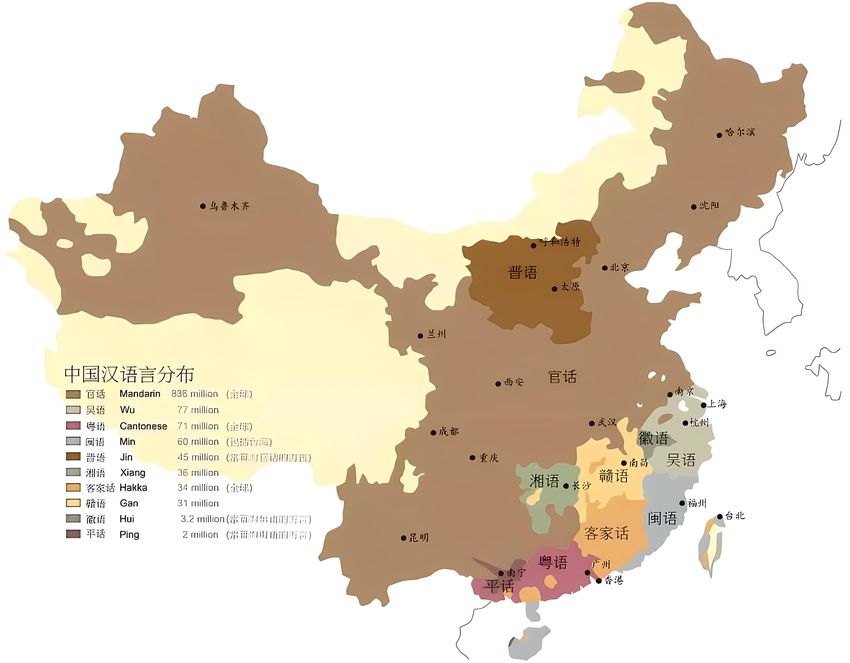China has a vast territory, and there are many and complex dialects of Chinese and minority languages. Do you know what Chinese dialects are? What are the seven major dialects of Chinese? This article counts the top ten dialects in China, including Mandarin dialect, Wu dialect, Min dialect, Hunan dialect, Hakka dialect, Gan dialect, Cantonese dialect, Jin dialect, Huizhou dialect, etc. How many of these local dialects do you know? Please see the detailed introduction below.
01.Mandarin dialect
02.Wu dialect
03.Fujian dialect
04.Hunan dialect
05.Hakka dialect
06.Gan dialect
07.Cantonese dialect
08.Jin dialect
09.Huizhou dialect
10.Pinghua

1. Mandarin dialect
Mandarin dialect is a collective term for some northern languages defined based on Beijing dialect, that is, northern dialect in a broad sense (except Jin dialect, etc.). Among the major dialects of Chinese, the Mandarin dialect has its prominent status and influence. The Mandarin that is now promoted across the country was developed on the basis of “Beijing Mandarin”. The Mandarin dialect has strong internal consistency. It has the widest distribution area and its speakers account for about 73% of the total Han population. Mandarin can be subdivided into eight sub-dialects: Northeast Mandarin, Beijing Mandarin, Hebei-Lu Mandarin, Jiao-Liao Mandarin, Zhongyuan Mandarin, Lanyin Mandarin, Jianghuai Mandarin, and Southwest Mandarin.
2. Wu Dialect
Wu dialects are called Wu dialect, Jiangdong dialect, Jiangnan dialect, Jiangzhe dialect, and Wuyue dialect. In China, it is distributed in present-day Zhejiang, southern Jiangsu, Shanghai, southern Anhui, northeastern Jiangxi, and northern Fujian, with a user population of more than 90 million. Wu dialect is a language of the Chinese language family of the Sino-Tibetan language family and one of the seven major dialect collections in China. Wu dialect has tens of thousands of unique words and many characteristic characters, which are a vivid reflection of Jiangnan people’s way of thinking, life style, cultural cultivation, social production, customs and language habits. Wu dialect retains many ancient Chinese characters and expressions, which has high cultural value.
3. Fujian dialect
Fujian dialect, also known as Min language, is the Min branch of the Chinese family of the Sino-Tibetan language family. There are about 80 million people whose mother tongue is Min dialect. It originated and is mainly distributed in Fujian, but also in southern Zhejiang, Taiwan, Guangdong, Hainan and overseas. , Min language also has considerable influence in areas where Chinese people live in other countries, and its influence among overseas Chinese is second only to Cantonese. The Fujian dialect can be divided into five sub-dialects: Eastern Fujian, Southern Fujian, Northern Fujian and Central Fujian, and Puxian.
4. Hunan dialect
Hunan dialect(Xiang dialect), also known as Xiang language or Hunan dialect, belongs to the Chinese subgroup of the Sino-Tibetan language family. It is the main language used by the Hunan people living in the Xiangjiang River Basin and its branches. The Hunan language is divided into New Hunan and Old Hunan. New Xiang is represented by Changsha dialect, and Old Hunan is represented by Shuangfeng dialect. Modern Xiang dialect speakers are mainly distributed in quite a few areas of Hunan Province in mainland China, including Changsha, Zhuzhou, Xiangtan, Yueyang, Yiyang, Loudi, Hengyang, Shaoyang, Yongzhou, etc. According to statistics in 2010, the number of speakers of Xiang language was approximately 45 million. The Xiang language has 20-35 initial consonants, 30-40 finals, and 5-7 tones, with the majority being 6.
5. Hakka dialect

Hakka dialect, also known as Hakka language, referred to as Hakka language, is the main language used by the Han Hakka ethnic group. It is Chinese and one of the official languages (legal official language) in Taiwan, China. Hakka is also known as Hakka in informal situations. According to accent, Hakka can be divided into Meizhou dialect, Huiyang dialect, Huizhou dialect, Gannan dialect, Tingzhou dialect, etc.
6. Gan dialect
Gan dialect, also known as Gan language, is Chinese Chinese, commonly known as “Jiangxi dialect”, and is the main language used by the Jiangyou ethnic group of the Han nationality. Most of the user population is in Jiangxi Province, mainly distributed in the middle and lower reaches of Ganjiang River, Fuhe River Basin and Poyang Lake Basin and surrounding areas, eastern Hunan and northwest Fujian, southwestern Anhui, southeastern Hubei and southwestern Hunan. In addition, there are a few Gan dialect islands in Zhejiang and Shaanxi. There are around 55 million speakers of Gan dialect. Gan dialect is represented by Nanchang dialect, Fuzhou dialect, Yichun dialect, etc. There is a high degree of interoperability among the dialects within Gan dialect.
7. Cantonese dialect
Cantonese, commonly known as vernacular, and overseas known as Tang dialect, is a tonal language of the Han family of the Sino-Tibetan language family, China, and is also the mother tongue of the Han Cantonese family. Cantonese is formed by the fusion of ancient Central Plains Yayan and ancient Cantonese. It has a complete set of nine tones and six tones, and perfectly retains the characteristics of ancient Chinese.
8. Jin dialect
Jin dialect is the only non-official dialect in northern China. Jin dialect has a population of about 63.05 million (“Chinese Language Atlas” 2nd edition, 2007). The main speaking areas are Shanxi Province, the central and western parts of Inner Mongolia Autonomous Region, northern Shaanxi Province, Most of Henan Province north of the Yellow River and western Hebei Province span 175 cities and counties. The core areas of Jin dialect are mainly Taiyuan dialect (which has been divided into old and new schools) and Luliang dialect. Most Jin dialects have five tones, and some areas have six, seven or four tones.
9. Huizhou dialect
Huizhou dialect, also known as Hui language and Yanzhou dialect, is one of the 13 first-level dialects of Chinese. It is mainly distributed in ancient Huizhou Prefecture, most of Yanzhou Prefecture, and parts of Raozhou Prefecture on the upper reaches of the Qiantang River, with a speaking population of more than 4 million. Compared with Wu dialect and Gan dialect, Hui dialect has the characteristics of both. For example, the initial consonant system is close to that of Gan dialect, while the final system is close to that of southern Wu dialect. Due to the changes in the administrative center, Tunxi dialect has become the representative pronunciation of Huizhou dialect.
10. Pinghua
Pinghua is a dialect of Chinese in Guangxi. It is still unclear which dialect of Chinese it belongs to. Some scholars or dialect books and periodicals classify Pinghua as Cantonese, while others believe that Pinghua is an independent dialect. Pinghua is mainly distributed in urban suburbs, market towns and rural areas near railways, rivers and other transportation lines in Guangxi. There is generally no concentrated distribution in urban areas (with the exception of a few small cities, such as Binyang, where most people speak Pinghua). The suburban counties of Guilin, Yongfu and Nanning have a higher concentration of Pinghua residents. The population that speaks Pinghua, the text description of A2 “Chinese Dialect Map” in the “Chinese Language Atlas”, and the text description of Figure B14 all say that the population that speaks Pinghua is about two million.